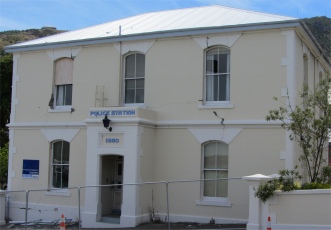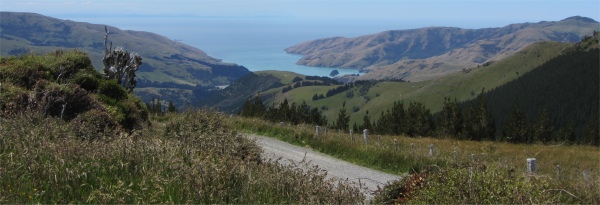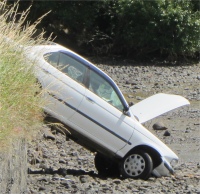 Sumner Beach |
The plan today was to explore Lyttelton and Banks Peninsula. I chose a route via Sumner and over the tops to drop down to Lyttelton.
Once I was driving through the east side of the city, nearer to the epicentre of the earthquake, the roads were buckled and distorted. It paid one to keep one's eyes glued to the bumps and holes, and be aware of cyclists suddenly swerving as they tried to avoid the obstacles. Lampposts leaned at crazy angles. Bridges with their support pillars firmly rooted into bedrock still stood proud, but the roads leading to them had dropped, so for those that did not have steel ramps onto them, it was a case of bumping up onto a bridge and dropping off the other end. I'm sure that did the wagon's suspension a world of good.
A beautiful wide sweep of sandy beach graced Sumner, with the blue sea gently breaking onto the shore, circling the sandcastles kids had made to defend their "territory". The illusion was shattered when I turned round on myself and stared in land. Half the road was taken up by several hundred metres of ship containers stacked two high. These had been installed after the quake to prevent further rubble from the crumbling cliffs smashing into passing vehicles. High up on the cliffs stood halves of houses, the other halves were strewn down the cliffs and smashed to pieces at the base. It was a sorry sight.
 Downtown Lyttelton |
 Houses Collapsed Down the Cliffs at Sumner |
Southeast of Christchurch, the Port Hills tumbled down to the city's and the South Island's largest port at Lyttelton. The small town was actually perched on the slopes of a drowned volcano crater which now formed Lyttelton Harbour. Being a major disembarkation point, the town was the first introduction to New Zealand for countless European migrants. The town was surrounded by turn-of-the-century weatherboard cottages and, before the quake, stone buildings that nestled in the hillside. Lyttelton's streets still catered to the local lifestyle; busy with commercial outlets, boutique shops, restaurants and caf�s proudly serving home roasted coffee and fresh produce with eclectic global influences. Sadly only a portion of its premises were operating, others had fallen victim to the earthquake. The town also had some containers revamped into new premises. It seemed containers were the new universal building block since the quake. Plastic hoses snaked along pavements providing the only source of fresh water to some hard hit premises.
 The 1880 Police Station Cracked Up |
 The Tin Palace Survived Because it was Made Out of Tin |
On a corner of a piece of wasteland, a silver birch tree stood alone, adorned with bright silvery decorations. Tied on to a barrier below it was a bunch of flowers. Some poor soul(s) must have perished inside what once had been a building.
I left the quaint town and weaved my way around the head of Lyttelton Harbour to Diamond Harbour, almost opposite Lyttelton. Once parked up, I walked down a path through tall pine trees. My that was bliss, I always enjoy the resinous vapours given off by such trees.








